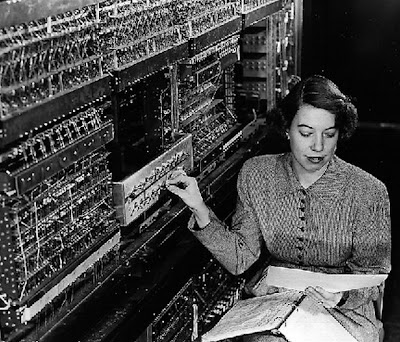Here is glimpse of the history of computers and their humble beginnings. These computers may not have been as powerful as modern computers, but they’re old black and white photos are intriguing nevertheless. If for no other reason, then because those old computers were capable of filling a whole room with their robust circuitry. Enjoy these old photos of the first generation of computers.

1. AVIDAC, Argonne’s first digital computer, began operation in January 1953. It was built by the Physics Division for $250,000. Pictured is pioneer Argonne computer scientist Jean F. Hall.
2. The first ever computer in Latvia was developed and made at the start-up Institute of Electronics and Computer Science in early sixties. No computers were made industrially in USSR at that time. Therefore successful completion of that project certainly represented a significant achievement. Built on a lot of vacuum tubes, the computer actually worked well and was used for supporting research activities for several years till the time when it became possible to replace it by a more powerful industrially made computer.
3. The CSIRAC was Australia’s first computer. The name stands for CSIR originally stood for “Council for Scientific and Industrial Research”. This name was in effect from 1926 to 1949.
4. A man and woman working at a Ferranti Pegasus computer. This computer was a classic 1950s/1960s mainframe installation, taking up the majority of space in a room.
5. First ever apple computer running windows. This is an Apple II with a monochrome screen and PC emulator hardware installed. The board was called the 88 Card, “the only fully functional 8088 processor for the Apple II personcal computer.
6. First hard disk The rotating drum technology allowed ERA to deliver the world’s first production stored-program computer (ATLAS – ERA 1101) to a customer site in October 1950. The engineers making the installation delivery to the National Security Agency predecessor were Frank Mullaney and Jack Hill. As shown in the photo below, these drum products came in various sizes. They were first used in several classified processors, then in the early 1100 computer series and the UNIVAC SS-80 and SS-90 computers. Dr. Cohen and Sid Rubens are credited with patenting the rotating magnetic drum. The drum development engineers and management shown in this early 50’s photo, left to right are: William Keye, Arnold Hendrickson, Robert Perking, Frank Mullaney, Dr. Arnold Cohen, and John ‘Jack’ Hill.
[sumber: chilloutpoint.com]











![Perihal Sifat Besi & Jenis Besi & Keistimewaan Besi Dalam masyarakat Melayu [ Besi Kuning, Besi Khursani, Besi Keris, Tahi Besi, Mimpi Besi ]](https://blogger.googleusercontent.com/img/b/R29vZ2xl/AVvXsEhZpFwHKggONAW98nSw7QO0GJlf0nIMfnPNcaV0blgGA0Qd_lTQpf8fFXj9f_BJC814dl_edptE2mk3d7IwnCmlW6GpipuLn0eWRmvbas1EHZFYY0egfqGy6sU8E0ZaAcJzW8bImZg5a8dr/w72-h72-p-k-no-nu/besikuning.jpg)







2 Ulasan